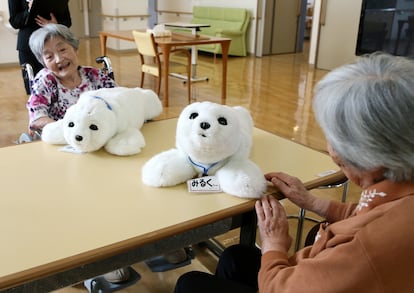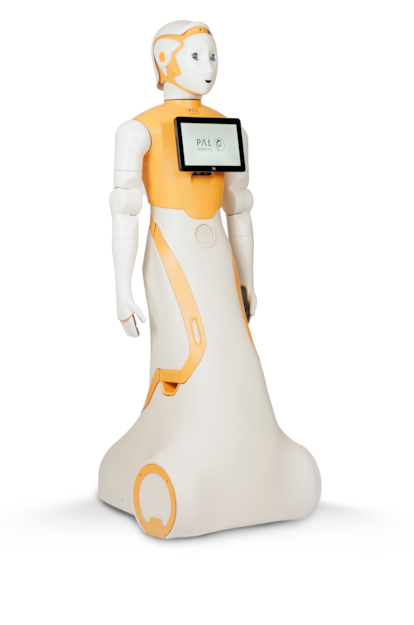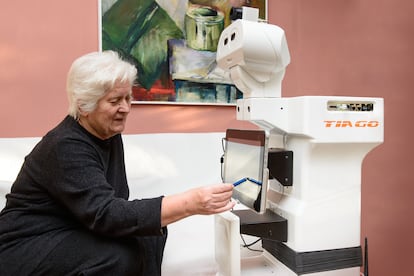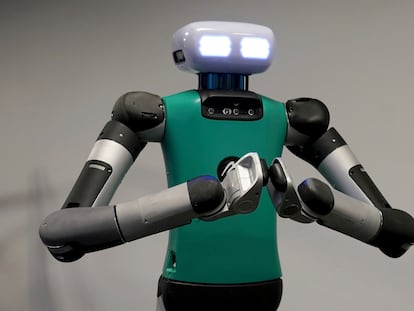Care of the future: Can robots care for the elderly or the sick?
Experts agree on the potential of machines to take on specific tasks, such as reminding someone to take medication, or tracking a patient’s moods. However, they warn that robotics alone isn’t enough


Nine years ago, a plump white robot — with a round head and tiny black eyes — reached the screens and hearts of millions of people… both children and adults alike.
This was Baymax, the protagonist of Disney’s Big Hero 6, an endearing character inspired by one of Marvel’s lesser-known comics. It didn’t take long for the film to become a classic and for toy versions of the adorable machine (who resembles a pillow) to be sold everywhere.
But Baymax — in addition to being huggable and marshmallow-like — has another function: he’s a caretaker robot. “I am Baymax, your personal healthcare companion,” he introduces himself in the film. The rotund machine can detect when someone is hurt: he’s armed with a scanner to analyze vital signs and can treat any ailment, both physical or emotional.
This isn’t the first movie robot that the public has fallen in love with. Wall-E, Astro Boy, R2-D2 and his companion C3PO achieved this well before Baymax, while films such as Terminator or Blade Runner laid the foundations for the genre. However, Baymax is one of the few robots to have appeared on the big screen who was created with the objective of caring for human beings.
Stories about robots that care for the sick or the elderly have been making headlines for years. In Japan, the promotion of care robotics in hospitals or nursing homes has been the order of the day for decades. Assistive robotics is presented as a solution to the care crisis in a society that’s rapidly aging, where the duration and requirements of long-term care only continue to grow, without the necessary public investment to alleviate pressures.
Such a solution isn’t without backlash. This past week, the regional government of Catalonia in Spain announced that it will allocate the equivalent of $6 million to purchase 1,000 service robots to care for the elderly. However, the union of professional caregivers denounced that this measure is merely designed to replace them, not to improve their working conditions.
As artificial intelligence (AI) increasingly infiltrates everyday tasks, it has been more frequently considered as a potential helper in the long-term care sector. With an unstoppable advance, a future filled with super caring machines no longer seems like something out of a movie. But can robots really care for the elderly or sick? How would they do so? And what ethical implications does this have? Where’s the limit?
This past July, the journal Science Robotics published a report — carried out by researchers at the universities of Auckland, Duke and Cornell — on how companion robots (equipped with AI) can become tools to help improve the social connections of single people. Elisabeth Broadbent — a professor of Psychological Medicine at the University of Auckland and one of the researchers who participated in the study — explains to EL PAÍS via email that “it has already been shown in scientific studies that robots reduce loneliness” and that machines specifically designed to accompany people already exist. One of these is manufactured by the company PARO. It’s a small therapeutic robot that resembles a baby seal. Looking like a stuffed animal, it was offered to people who survived the earthquake and tsunami that devastated the coast of Japan in 2011.
“Robots can connect people through video calls and remind them of their social commitments. With new AI large language models, robot conversations can be more personal and tailored to the user,” Broadbent notes. This personalization, she continues, is what makes those who use them feel heard and cared for. Machines “can also learn about people through repeated conversations and remember to follow up on important topics.” But for this to be possible, she clarifies, human control is necessary to regulate the use and guarantee equitable access to this technology. Personal data must be kept private and the information provided by the machine needs to be completely reliable. There must be a human check in case the robots make a mistake.
Irene Lebrusán — a sociologist and researcher at the International Center on Aging (CENIE) — thinks that it’s key to differentiate between unwanted loneliness and boredom. “If you take a lady who’s alone all day and give her a doll, the lady will be entertained for a while. Does that mean we’ve addressed her problem of unwanted loneliness? Absolutely not. Unwanted loneliness means having insufficient or low-quality social relationships. A machine will never, ever be able to solve this issue,” she warns.

Regarding the responsibility that Broadbent spoke of, Alan Winfield — an engineer and professor of Robot Ethics at UWE Bristol University — expresses his similar concerns to EL PAÍS: “One of the things that worries me — especially with older people, children or people with intellectual disabilities — is that they may come to believe that a robot cares about them.” He believes it’s necessary to precisely define the type and function of robots that are used for care: to differentiate those meant to provide company and emotional support — such as the automated seal — from those that provide physical and medical assistance. In the latter category, the risks are greater. “In the end, these care robots take on functions that may seem simple, but they’re actually critical, such as reminding a person to take their medication, or keeping track of the number of times a patient has had a drink of water.”
In the event that something goes wrong, the key thing for Winfield is to specify what exactly went wrong, why it occurred and how to avoid it. To this end, he and his team advocate for the creation of “ethical black boxes.”
“This is the robot equivalent of an aircraft flight data recorder. An airplane wouldn’t be allowed to fly without it. All robots — especially social ones, which include assistive robots, robots in hospitals, in nursing homes or in private homes — must be equipped with one,” he affirms.
Even so, the professor believes that, for now, caregiver robots can perform simple tasks, such as bringing a glass of water from the kitchen to someone, or transmitting an elderly person’s call for help. But he emphasizes that we’re far away from these machines being deployed to long-term care homes or being allowed to physically assist people as they dress or undress, or get in or out of bed. “[Robots] still can’t do that safely and reliably. We need testing, safety guarantees and regulations. We also need to understand that assistive robots should never be used as substitutes for human caregivers. They should help them, not replace them,” he warns.

In Spain, one of the leading companies in assistive robotics is PAL Robotics. Founded in 2004, its machines are marketed throughout the world. The company has participated in several pilot projects in the European Union with two of its humanoid robots, named ARI and TIAGo. These robots are designed to help elderly people in their daily tasks.
Narcis Miguel Baños — the head of the Social Robotics unit at the firm — sees a future “where assistance robots play a key role.” But to build that future, he says that it’s essential “to conduct many more pilot tests in ‘real’ environments” and for engineers and care professionals — including doctors, nurses and homecare workers — to collaborate. “Maybe we designed a mobile robot that can do things with its arm and move objects up and down, but what we envision as engineers may not be what the market and people need,” he acknowledges, in a video interview with EL PAÍS.
Today, Baños points out, “all these types of robotic applications are still in the research phase” and the next step is to “specify what type of tasks we want each robot to do. We must be very specific.” One of the main difficulties that the expert warns about is balancing individual needs with collective needs. Making these machines socially-acceptable is also a challenge. “Medical help is easier to understand than the idea that this robot can also offer emotional support to a person.”

Silvia González — head of AI at the Technological Institute of Castilla y León (ITCL) — agrees that emotional support from robots “is taking its first steps.” In January, tests began with Pepper — a humanoid robot designed in Japan — in a care center for the elderly. “The key is to adapt it so that users don’t feel diminished, but rather see that they’re capable of doing things [with the help of the machine]. But there’s still a long way to go before a normal conversation can take place, where gestures are identified and the robot can know if you are happy or sad.”
How could this be done? Well, González explains that, if a person takes longer than usual to respond, or stops doing their recommended exercises — which they may have been doing without a problem — “the system can determine that there’s a lack of attachment to the robot and that something is wrong. Something may have happened to the patient.”
Demystifying Japan
Back in 2007, James Wright — a professor at Queen Mary University of London — became interested in robots, especially the advances being made in Japan, while completing his thesis. “At first, I really thought that robots would become very popular and common. And then, I went to Japan,” he explains via video call.
He spent several months in the country, touring care centers and talking to workers and patients. From these visits, the book Robots Won’t Save Japan (2023) was born. “There was a disconnect between the people developing the robots and the end users. New types of tasks emerged, like having to move them [from one place to another], constantly [informing] the residents about them, updating them, cleaning them…”
The professor warned then — and reaffirms now — that extending the use of caregiver robots is going to be much more complicated than what has been promoted. “I talked to several nursing home administrators who bought a robot. It often ended up sitting in a closet, because they didn’t have staff to supervise the use of it throughout the day. Japan predicted that the future market would be [dominated] by these types of robots, with half-a-trillion dollars a year being spent on them by 2025. It hasn’t happened. The reality is that these devices are really expensive and don’t save on labor.”
For Wright, before deciding which machines will do what (and how and when), society must first answer the following question: “What does it mean to care?”
Sign up for our weekly newsletter to get more English-language news coverage from EL PAÍS USA Edition
Tu suscripción se está usando en otro dispositivo
¿Quieres añadir otro usuario a tu suscripción?
Si continúas leyendo en este dispositivo, no se podrá leer en el otro.
FlechaTu suscripción se está usando en otro dispositivo y solo puedes acceder a EL PAÍS desde un dispositivo a la vez.
Si quieres compartir tu cuenta, cambia tu suscripción a la modalidad Premium, así podrás añadir otro usuario. Cada uno accederá con su propia cuenta de email, lo que os permitirá personalizar vuestra experiencia en EL PAÍS.
¿Tienes una suscripción de empresa? Accede aquí para contratar más cuentas.
En el caso de no saber quién está usando tu cuenta, te recomendamos cambiar tu contraseña aquí.
Si decides continuar compartiendo tu cuenta, este mensaje se mostrará en tu dispositivo y en el de la otra persona que está usando tu cuenta de forma indefinida, afectando a tu experiencia de lectura. Puedes consultar aquí los términos y condiciones de la suscripción digital.
More information
Últimas noticias
The open war against the oil ‘phantom fleet’
‘Sleepless City’: The light of cinema illuminates Madrid’s Cañada Real shantytown
Christmas loses its festive spirit: ICE fears cast shadow over religious celebrations
Russell Tovey: ‘I was advised many times not to come out, I don’t think there was many people who’d done that — and I feel really proud that I’m one of those that did’
Most viewed
- Families demand repatriation of bodies of Colombians who died in Ukraine: ‘This war is a slaughterhouse for foreigners’
- The low-cost creative revolution: How technology is making art accessible to everyone
- Liset Menéndez de la Prida, neuroscientist: ‘It’s not normal to constantly seek pleasure; it’s important to be bored, to be calm’
- Christian Louboutin: ‘Young people don’t want to be like their parents. And if their parents wear sneakers, they’re going to look for something else’
- ‘El Limones’ and the growing union disguise of Mexican organized crime









































